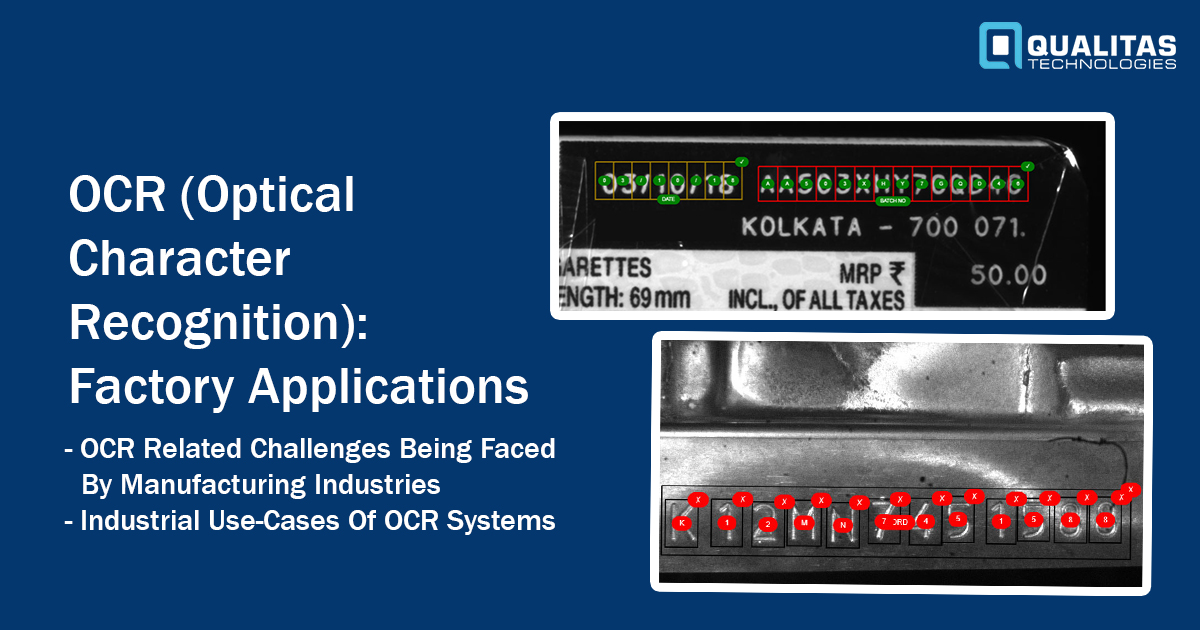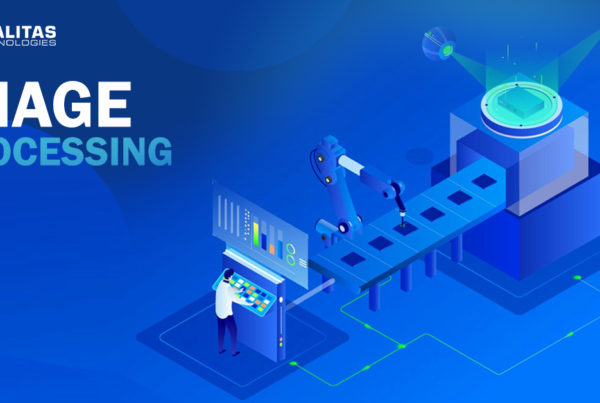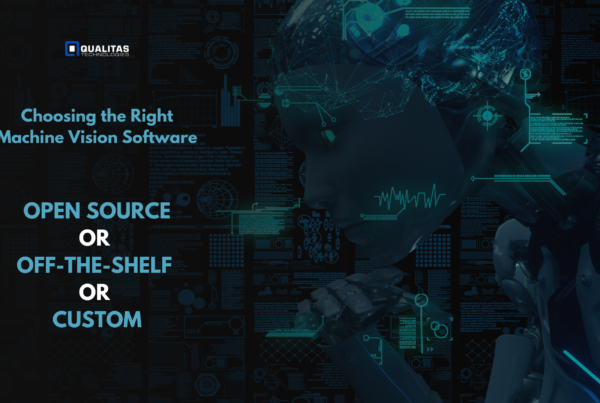
Table Of Contents
1. Introduction
2. Types of OCR Systems Used in Manufacturing Industries
3. How AI Is Different from A Rule-based OCR System
4. OCR-related Challenges Being Faced by Manufacturing Industries
5. Industrial Use-cases of OCR Systems
6. Benefits of AI-based OCR Systems
7. Qualitas’ Solution for Multiple Industrial Challenges
8. Conclusion
Introduction
OCR (Optical Character Recognition) technology has been in widespread use ever since the 1990s. OCR helped business owners automate the processing of physical documents. The quality of OCR has continuously improved since its inception and is now one of the most powerful tools in the world. Nowadays, OCR systems can convert printed, handwritten, text, and even embossed information into a digital format that is electronically readable.
In fact, the global optical character recognition market size was valued at US $7.46 billion in 2020 and is expected to expand at a CAGR of 16.7% during the forecast period of 2021-2028. Let us now delve into the types of OCR systems prevalent in different manufacturing industries
Types of OCR Systems Used in Manufacturing Industries
The different types of available OCR systems are:
- Intelligent Word Recognition
The IWR technology captures handwritten texts or cursive texts. Instead of picking up individual characters, their algorithm recognizes an entire continuous handwritten word.
- Intelligent Character Recognition
Like IWR, ICR captures handwritten or cursive texts. However, their algorithm identifies a single character at a time.
- Optical Word Recognition
The OWR technology performs text recognition on the typewritten text and reads the data word by word.
- Optical Character Recognition
OCR performs text recognition on the typewritten text and reads data one character at a time.
- Optical Mark Recognition
The OMR technique gathers human input data by identifying marks or patterns on a document.
How AI Is Different from A Rule-based OCR System
OCR solutions can perform text recognition via two approaches: rule-based and AI-based. In the rule-based or template-based approach, an area defined by specific coordinates is inspected based on a lot of rules hardcoded in the form of if-else statements. As long as the samples fall in the ideal category, there are no issues. However, even a slight variability in the sample can lead to an error stream. Under the traditional, rule-based OCR, the user’s only way to increase the reliability of scans is to evaluate and monitor the outputs manually.
The traditional OCR solutions have become incompetent in the modern landscape. Companies have now started focusing on AI-driven alternatives to augment the net productivity while keeping the costs in control. Based on the samples, AI-based OCR solutions develop rules on their own and continually improve them while performing. Concisely, technologies such as Deep Learning help OCR solutions to increase their accuracy over time.
OCR-related Challenges Being Faced by Manufacturing Industries
The OCR systems have a few limitations that restrict their efficiency and their scope of applications. Some of these challenges are the following:
- Conditions of uneven lighting
Capturing images in natural environments can often result in shadows and uneven lighting. This degrades the required characteristics of the image and makes accurate detection, segmentation and text recognition difficult.
- Blurring
When capturing a moving item, if the shading rate of the camera is not sufficiently high, the sensor gets exposed to a continually changing scene. Thus, blurring is often observed in their images.
- Fonts
Italic font style and script font style might result in overlapping of characters, making OCR processes such as segmentation difficult. Also, characters of several fonts have large within-class variations and many pattern sub-spaces, making it challenging to perform text recognition.
- Warping
Text on objects of varying geometries can be challenging for OCR to be recognized.
- Challenging background
OCR systems often have to take a color/ greyscale photo and then convert it into plain black and white. This is done to reduce blurred text and better separate black and white text from the background.
- Skewness (Rotation)
If the object is not properly aligned or skewed to some degree, the resulting images will yield poor results when fed into the OCR classifier. Thus, the images have to be de-skewed first using techniques such as the RAST algorithm, methods of Fourier transformation, etc.
Industrial Use-cases of OCR Systems
Some important use-cases of OCR systems across various industries have been mentioned below:
- Automotive industry
The production processes, even for a single automobile, can be quite complex. It is crucial that each part ends up in the right vehicle and in the proper order. Nowadays, manufacturing industries stamp serial numbers onto the parts to avoid complications in the production line. OCR systems can read perform text recognition and verification in real-time to ensure that parts are labeled correctly.
- Pharmaceutical industry
Batch codes, lot codes and expiration dates play a critical role in the pharma industry. Stringent labeling regulations are enforced to ensure customer safety and to eliminate product counterfeiting. OCR technology helps verify that all the significant information on the package is legible and accurate, thus preventing any awry complications.
- F&B industry
The F&B industry has the most variety of packaging as compared to any other. To ensure product quality and safety, it is necessary to control the standard information printed onto the products. Some applications of OCR text recognition systems in this industry are production tracking, label verification, material receiving, lot code verification, and many more.
- Steel industry
In the large-scale production of metal sheets and pipes, it is important to utilize an effective way to continually inspect the products passing through the production line. AI-based OCR can help with steel pipe character identification by introducing automation with high accuracy.
- Banking industry
The banking sector is one of the largest consumers of OCR technology as it helps them enhance security, optimize risk management, improve data management and improve customer experience. With OCR technology, it is now possible to digitize and store a humongous volume of documents that can be accessed easily. OCR solutions facilitate real-time inspection of checks and a signature by scanning them via OCR-based software. Also, the electronic deposition of checks via OCR technology helps in fraud prevention and secure transactions.
Also, Read– Cylinder OCR Inspection
Benefits of AI-based OCR Systems
OCR offers a vast range of benefits to its users. Some of the important benefits of OCR are mentioned below:
- Improved accuracy
Software-based optical character recognition eliminates the scope of human errors. Thus, we can be ensured of accurate text recognition and reliable data. Higher accuracy translates to lesser product recalls complaints and increased consumer satisfaction. OCR can also help industries find and eliminate counterfeit products from entering the supply chain.
- Cost optimization
By automating the process of text recognition and verification, OCR solutions minimize the associated labor costs. This technology does not demand a lot of resources which brings down the processing costs and consequently reduces the overall costs of a company.
- Automates data entry into ERP software
If you frequently omit data or collect incorrect data during the data entry process, the final data becomes partly useless. OCR solutions can automate the erroneous task of reading documents such as invoices and feeding accurate data into ERP software.
- Compliance with government regulations
Industries such as FMCG, F&B, and pharma have to follow strict government regulations. Some of the standards are cosmetic suitability, packaging safety, and informative texts for the end-user. Using OCR helps such industries comply with these standards.
- Enhanced customer satisfaction
The ease of accessibility of significant searchable data by the consumers ensures higher customer satisfaction and a better customer experience.
- Improved productivity
The ease of tracking and tracing each product down the production line creates a stress-free environment for the workforce. OCR solutions also minimize the involved redundant manual work, saving employees the time to focus on tasks of greater importance and thus, boosting the overall productivity of the business.
Qualitas’ Solution for Multiple Industrial Challenges
We at Qualitas Technologies, believe in helping our clients overcome industrial challenges with the best of AI and vision technology. To overcome the numerous OCR-related challenges, Qualitas Technologies has developed an Optical Character Recognition (OCR) solution by leveraging cutting-edge Artificial Intelligence (AI) technology. Our solutions are successfully running in a vast range of industries, employed in different applications.
Our OCR solution utilizes the latest deep learning technology to read and difficult-to-read and complex characters. Deep Learning technology has been successful in achieving over 98% read rates, with over 97% accuracy in catching errors. The main differences between our OCR solution and the traditional alternative are the following:
- It can read any style of characters even if the input images differ in characteristics from the trained sample ones.
- It offers much higher accuracy, comparable to human read rates, but with very less processing time.
- It can read multiple types of fonts easily with an accuracy of over 99%.
- It is easy to train via a point-and-click interface.
- It can read characters that are hard to read or with a challenging background.
Conclusion
In this blog post, we discovered the ins and outs of OCR technology. Firstly, we understood the development of OCR over time and the types of OCR technologies used in industries. We then understood the differences between rule-based OCR and AI-based OCR and how the modern-day AI-based OCR solutions have the edge over the traditional options. Next, we discussed the OCR-related challenges faced in the industrial world. We also understood the benefits of OCR technology and its numerous use-cases.
Get In Touch With Us





